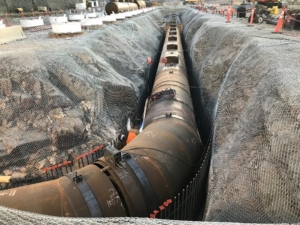The U.S. Environmental Protection Agency (EPA) rang in 2023 with a new program designed to provide funding for critical water infrastructure projects. Now, the EPA is providing loans to state financing authorities which are also known as state revolving fund programs. This new program was named after the law Congress passed to create it. It is called the State Infrastructure Financing Authority Water Infrastructure Finance and Innovation Act (SWIFIA).
This first-ever SWIFIA loan of $500 million was issued on Jan. 5 to the New Jersey Infrastructure Bank. The funding will be used to support various water projects throughout the state. The projects will all be designed to modernize, improve and/or expand water systems that serve a cumulative population of 10 million New Jersey citizens. Many of the projects include replacement of old water pipes.
The SWIFIA program is a recent extension of EPA funding for water-related projects. At the start of 2023, the agency had already issued $17 billion in credit assistance for a combined $36 billion in water projects. That total is increasing daily. The EPA is currently accepting letters of interest for another $6.5 billion available for water projects under the WIFIA program. That annual funding revenue is available to be leveraged to support $13 billion in water infrastructure improvements across the country.
On Jan. 18, the governor of New York announced a combined $143 million in financial support for seven state water projects. The funding came from the EPA program and was allocated to the New York State Environmental Facilities Corporation. In 2023 it will be used to broaden an already expansive pipeline of water projects in various stages of development.
Another $100 million water project in New York City is currently in the pre-design stage. Officials at the City Municipal Water Finance Authority will oversee an effort to improve water resources for the largest city in America. The immediate objective will be to provide redundancy for the city’s water system while allowing greater flow control and management of water supplies throughout the city. The project will require excavation and tunneling work before the water infrastructure improvements reach the construction stage.
A $91 million project in Bell County, Texas will help water authorities maintain critical supply lines amidst persistent drought conditions. The Brazos River Authority will spearhead the large initiative that will include construction of a new underground pipeline between two bodies of water within the county. The pipeline will carry water from Belton Lake to the reservoir at Stillhouse Hollow Lake as a way of offsetting drought impacts on the region’s water supplies. Construction of the pipeline will satisfy objectives identified in the county’s drought plan while also mitigating the impacts of recurring flood events.
The Southern Nevada Water Authority (SNWA) located just outside Las Vegas, Nev., recently received $130 million in funding for water infrastructure projects that will be structured to promote sustainability and economic development. The plan is to build a new network of pipelines to convey water to an 11,000-acre industrial park for technology and manufacturing businesses. The objective will be to reduce demand impacts on the Colorado River while supporting an economic development site located 20 miles from the Las Vegas Strip. Planning documents indicate that wastewater from the industrial park will be sent to a treatment site in Garnet Valley where it will be disinfected and recycled back into Lake Mead. The project will launch in 2023.
The SNWA will also oversee another very large initiative – the Horizon Lateral Project – which will significantly expand regional water supplies. It will include the construction of 24 miles of pipeline, two pump stations, a 40-million-gallon reservoir, and several rate-of-flow control stations. When completed, the effort should boost regional water resources by adding another 306 million gallons per day (MGD) to the system’s capacity. This $1.6 billion plan is currently in design development.
In the Massachusetts city of Newburyport, local officials are budgeting $18 million for a new pump station and raw water line. The plan is to connect the Indian Hill Reservoir with an existing raw water station so the city can manage its reservoir system more efficiently. The project will also mitigate potential threats to municipal water quality, such as nutrient loading and flooding from the nearby Merrimack River. Planning documents indicate that design work will reach 30% completion by the end of 2023 and solicitation documents for construction will follow.
City officials in St. Cloud, Minn., plan to replace a water main at a cost of $16.7 million. The water infrastructure project will be scaled to meet the demands of recent population growth. The multi-million-dollar project will be designed to address concerns over quantity and quality of the local water supply in the context of recent surges in demand. It will include a more sophisticated, hydraulic model of distribution especially in areas where recent population growth has been concentrated.
America’s water infrastructure is of great concern and the new funding is available now to ensure that needed water resources are available for future generations and that water is clean and safe for drinking now.







